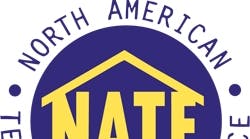NATE Offers Certification for Light Commercial and Refrigeration Installation & Service
When the Commercial Refrigeration Manufacturer’s division of the Air-Conditioning, Heating and Refrigeration Institute (AHRI) recognized the need to identify the proficiency of technicians who install and service commercial refrigeration systems, North American Technician Excellence (NATE) went to work. Enlisting the help of AHRI, subject matter experts from across the HVACR industry and technicians who volunteered to take beta tests, NATE developed four exams – two that certify technicians in the installation and service of light commercial refrigeration systems and two that certify them in the installation and service of commercial refrigeration systems.
According to Pat Murphy, vice president, certification at NATE, the 2- ½-hour, 100-question exams test the technician’s knowledge of the installation, service, maintenance and repair of commercial refrigeration systems.
“The exams cover light commercial equipment with fractional horsepower to 7.5, which encompasses convenience stores, fast-food chains and similar types of businesses. Larger equipment that is 7.5 to 80 horsepower is covered in the commercial refrigeration exams. “The benefits of certification are well documented,” Murphy explains.
“Each exam is difficult and provides a good measure of a technician’s knowledge,” Murphy says. “We’re not testing mediocrity. We’re testing excellence.”
“Airside tests conducted over the last 10 years show a 25% reduction in warranty claims. Evidence also shows that a certified technician can add as much as $10,000 in value to a company.”
Although anyone can take the exams, NATE recommends that technicians who take the installation exams possess at least one year of field experience working on refrigeration systems. Technicians planning to take the service exam should have two years of experience in the field.
“Each exam is difficult and provides a good measure of a technician’s knowledge,” Murphy says. “We’re not testing mediocrity. We’re testing excellence.”
Jon Perry agrees. Perry, the director of energy and maintenance at Farm Fresh Food & Pharmacy — a chain of 43 supermarkets operating in Virginia and North Carolina —helped to develop the exams by taking NATE’s beta test and encouraging other technicians from Farm Fresh and local contractors to join him.
“We’re one of the few supermarket chains that construct our own stores. We also have an in-house refrigeration group that installs and services the refrigeration systems in these stores, and we are always looking for ways to improve our skills and test our knowledge,” says Perry. “The NATE beta test provided a perfect opportunity to do that.” According to Perry, not everyone passed the exam. “It really is a difficult, challenging exam,” he notes. “But that’s okay, because I think it reinforces the value that our industry places on training and on NATE certification. By putting such a high regard on education, we continue to raise the bar for technicians and as a result, attract a high quality group of employees to our organization. That’s why I’m encouraging those who did not pass the exam to study and then take it again.
“In the meantime, I know their skills are improving as they study,” Perry added, “and we are developing a team of technicians who continue to be interested and actively questioning our processes. Farm Fresh is extremely proud of these technicians.”
As an incentive to take and pass the exam, Farm Fresh agrees to pay for the exam if the technician passes it. NATE helps, too, by providing what NATE has identified as the Knowledge Areas of Technical Expertise (KATE) on the organization’s Web site at www.natex.org. “The KATEs are outlines of the information covered in each exam,” explained Murphy. “They should be used as reference material by technicians who are preparing for the NATE exams, because they represent the knowledge, skills and abilities a technician should possess in order to pass the NATE exams.”
The NATE website at natex.org directs technicians to additional study materials and training resources, including a list of providers that offer training and testing. In addition, the site provides test results to technicians who have taken the exam. “The exams we offer are a direct result of organizations like Farm Fresh who voluntarily participated in our beta testing for the NATE commercial refrigeration certification program,” says Murphy. “By beta testing the exams we were able to find out which questions were working and which ones weren’t. The questions that didn’t work were modified, revised or eliminated, and when necessary new questions were substituted.”
The industry-developed and industry-tested exams are regularly reviewed by the NATE technical committee and updated as necessary. In addition, technicians are required to retest every five years or complete 60 hours of continuing education in their specialty to maintain their certification.
Perry believes recertification makes a lot of sense. “That’s because today, we're designing stores with technology that didn’t exist several years ago. In order to ensure that these stores operate as efficiently as possible, it is important that technicians be trained, certified and recertified in this new and changing technology. By doing so, we are establishing Farm Fresh as a long-term, progressive company.”








